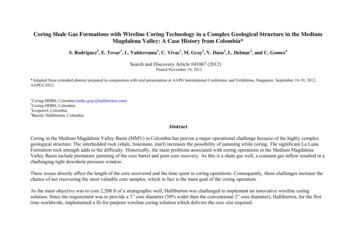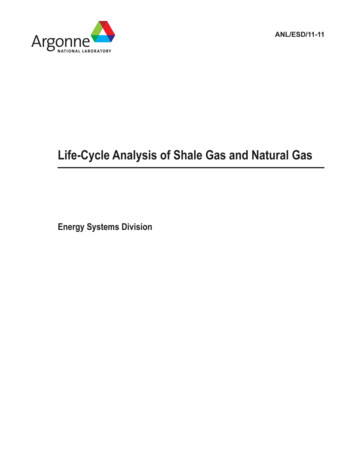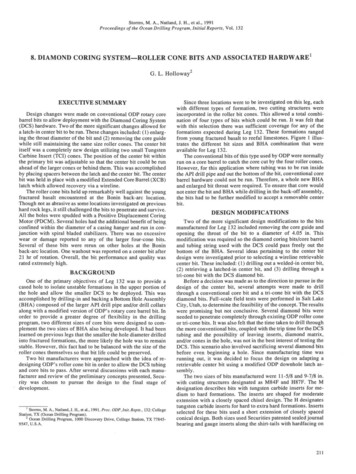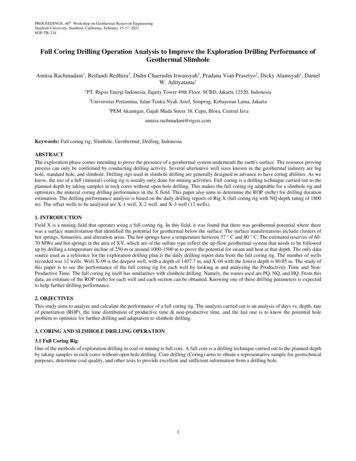
Transcription
Coring Shale Gas Formations with Wireline Coring Technology in a Complex Geological Structure in the MediumMagdalena Valley: A Case History from Colombia*S. Rodriguez3, E. Tovar3, L. Valderrama3, C. Vivas2, M. Gray1, V. Daza2, L. Delmar2, and C. Gomez4Search and Discovery Article #41067 (2012)Posted November 19, 2012*Adapted from extended abstract prepared in conjunction with oral presentation at AAPG International Conference and Exhibition, Singapore, September 16-19, 2012,AAPG 20121Coring-HDBS, Colombia (mike.gray@halliburton.com)Coring-HDBS, Colombia3Ecopetrol, Colombia4Baroid, Halliburton, Colombia2AbstractCoring in the Medium Magdalena Valley Basin (MMV) in Colombia has proven a major operational challenge because of the highly complexgeological structure. The interbedded rock (shale, limestone, marl) increases the possibility of jamming while coring. The significant La LunaFormation rock strength adds to the difficulty. Historically, the main problems associated with coring operations in the Medium MagdalenaValley Basin include premature jamming of the core barrel and poor core recovery. As this is a shale gas well, a constant gas inflow resulted in achallenging tight downhole pressure window.These issues directly affect the length of the core recovered and the time spent in coring operations. Consequently, these challenges increase thechance of not recovering the most valuable core samples, which in fact is the main goal of the coring operation.As the main objective was to core 2,200 ft of a stratigraphic well, Halliburton was challenged to implement an innovative wireline coringsolution. Since the requirement was to provide a 3” core diameter (50% wider than the conventional 2” core diameter), Halliburton, for the firsttime worldwide, implemented a fit-for-purpose wireline coring solution which delivers the core size required.
This paper describes an integrated workflow used to successfully implement such wireline coring technology. The workflow includes theorchestration of a multidisciplinary technical team that conjointly performed the interdependent processes which included the selection of thecore barrel type, core head, mud properties, best practices, and establishing the influence of the design of the bottomhole assembly over the corequality recovered. The wireline coring technology implementation proved to be such a success, that the operator decided to core 30% (800 ft)more beyond the initial coring plan. The result was 2662 ft of core recovered for 91% recovery rate.IntroductionThe stratigraphic targets for coring in the Medium Magdalena Valley (MMV) Basin were the La Luna and Simiti formations. The basin islocated in the central areas of the Magdalena River Valley between the central and eastern Cordilleras of the Colombian Andes. The primaryobjective of exploration efforts has been the search for structural traps in the Paleogene interbedded shale, limestone, and marl sections. Thesetraps have become the subject of intensified study.The MMV sedimentary record shows that the sequence of Jurassic continental deposits overlaid by Cretaceous sediments (calcareous andsiliciclastics) are of transitional to marine origin. The Paleogene sequence comprises siliciclastic rocks deposited under continental conditionswith some marine impacts. The basin exhibits rifting, thrusting and wrenching, which result in trap geometries (Agencia Nacional deHidrocarburos, 2007).Understanding that this is a shale gas play, the main objective of the coring project was to recover long interval samples of the La LunaFormation in order to conduct gas desorption analysis. A secondary objective was to ensure that quality core was provided to facilitate postanalysis of the samples.Figure 1 shows the stratigraphic details of the well.Coring Objectives Cut and recover coring samples from the La Luna Formation. The interval length is expected to be approximately 2200 ft. Coringoperations will stop when the Simiti Formation is encountered. Use the wireline RockSwiftTM system to reduce ‘core to surface’ trip time. Utilize the wireline RockSwiftTM system to reduce the trip time and surface handling time.
Enhance recovery and efficiency through the use of better core jamming identification technology. Deliver 3” core samples for gas desorption and other lab analysis. Once the coring operation starts, monitor the operational parameters to reduce jamming and to enhance recovery and core quality.To meet these objectives the following planning review and actions were taken.1. Planning the OperationHalliburton personnel, together with the Ecopetrol geology and drilling teams, analyzed drilling, geological, and operational data from wells inthe vicinity that were perceived to be analogous and portraying similar stratigraphic and structural contexts to the subject well. Unfortunately,the wells that provided the best formation references all had shallower true vertical depths (TVD) than the proposed La Luna well. As a result,although good information was obtained, ultimately, the section to core in this well was considered a truly exploratory horizon.The team confirmed that the laminar nature of the formation contributed to its propensity to induce jamming with resultant levels of poor corerecovery. Additional challenges in this La Luna operation included: Gas and water influx Dynamic balance/imbalance in the well Potential heterogeneity of the lithology Mud weight/solids controlThe RockSwiftTM system is a surface, pressure monitored system. As a consequence these conditions presented an interesting challenge for thecoring operational team.
2. Coring EquipmentFor unconventional fields, such as coal bed methane (CBM) and shale gas plays, Halliburton has developed new technology tools including theRockSwift wireline retrievable coring system. This enhanced technology allows a larger diameter core (3”) to be cut and recovered to surfacewithout the need to pull the entire assembly to surface. The 3” core is a considerable enhancement over the more conventional wireline systemswhere the standard sizes more commonly approximate a 2” diameter. Given the exploratory status of the reservoir, Ecopetrol planned to performan extensive testing program on the core. It was perceived the larger core diameter would give greater flexibility and scope in the analyticalphase.The RockSwiftTM system (Figure 2) has a LatchLess Triple Tube (LLTTS) configuration, with a wireline retrievable inner barrel allowing therecovery of continuous core samples without tripping pipe to surface.The system is designed to separate the drilling and the coring functions in order to simultaneously meet the drilling requirements in terms of corecut and safety (outer assembly) and the objectives in terms of core quality and core recovery (inner assembly). This separation is completedthrough the introduction of a median tube called the “Triple Tube” (TT).The RockSwiftTM system contains an inner assembly that is held down by hydraulic pressure rather than a latching mechanism. The inner barrelcan be brought to surface by conventional wireline and can be effectively used in a wide range of applications.The system consists of a heavy duty core barrel, a median tube assembly (the “Triple Tube Assembly”), and a retrievable Inner Tube (IT) (the“Inner Tube (IT) Assembly”). The TT is assembled on surface and positioned in the outer barrel. The TT allows the operator to monitor the mudflowing along the core, and it guides the IT assembly ensuring a smooth reception and landing in the corehead. Once seated, the TT providesadditional stabilization to the IT assembly, further enhancing core recovery and quality.The IT with deflector and swivel assembly is dropped from surface. Thanks to deflectors and a definable nozzle positioned in the swivel,hydraulic pressure seats the head assembly into the TT. Once positioned, a positive pressure indication on surface confirms that the IT assemblyhas properly landed in the core barrel.Once the inner assembly is seated, coring may begin.To retrieve the IT, a centralised overshot is run in on wireline which latches onto the swivel to retrieve the assembly and recover the core tosurface.
The RockSwiftTM system incorporates a jamming indicator, which proved crucial to the success of this operation. During the cutting phase,pressure increases are observed on surface giving clear indications of core jamming, allowing the operator to more accurately call for theretrieval of the IT assembly.3. Bottomhole Assembly (BHA) SelectionThe proposed BHA included the RockSwiftTM system with wireline retrievable inner barrel which require a minimum drill string drift of 4 1/8”(Figure 3). The drift is required to allow the passage of the swivel assembly when dropped and retrieved.The table below outlines the assembly used for coring:In order to accommodate the dimensions of the inner barrel and swivel, special drill pipe, heavy weight, and drill collars are required. The BHAwas composed of core barrel, 5 7/8” DT-55 HWDP, and 5 7/8” XT-57 DP.Using the technical specifications of this equipment a torque and drag analysis was performed (Figure 4):In addition, given the unconventional nature of the drilling assembly, HDBS undertook a MaxBHA analysis to identify any potentially criticaldynamic factors that could adversely affect the performance. Using the anticipated operating parameters, the results showed that below thecritical WOB of 15 Klb there was no buckling of the coring assembly anticipated.In addition the MaxBHA software helped identify optimum operating parameters, to avoid undesired vibration during the coring operation.Results summarized/exampled below (Figure 5):The RockSwiftTM system contains an inner assembly that is held down by hydraulic pressure decreasing the risk of snagging that can result fromthe use of a latched system release. The flow rate is calculated to ensure a window of sufficient pressure is maintained, so that the inner barrelremains seated under normal coring procedure (Figure 6).The flow/pressure hydraulic calculations were undertaken to ensure correct seating and retention of the inner barrel during the operation. Theseresults were then used during the preparation of the coring/operational plan.
4. Coring OperationThe operation started at 9376 ft in the La Luna Formation with a planned mud weight of 13.0 ppg. Early in the run the gas and water influxcreated well control challenges that resulted in the need to increase the mud weight from 13.5 ppg to 17.0 ppg. These changing wellboreconditions brought added challenges to the coring operation.The increased mud weight brought the well to a near dynamically balanced position. The mud weight window, to control the gradient betweeninflux and loss, was extremely small, and vigilant monitoring of the well during the coring operation was required. The excessive weight andsolids in the mud caused additional wear to the system components while the over-burden resulted in slower ROP. This over-burden furthercreated issues with over-pull when breaking the core that adversely affected the integrity of the core catcher mechanism.Ultimately, despite these arduous conditions, 69 coring runs were performed, 7 of them using a core barrel of 30-ft length; 54 runs using 60-ftcore barrel; and 7 runs with the 90-ft core barrel system. A total length of 2935.8 ft was cut with 2661.23 ft recovered, for a 91% total recovery.The average ROP for these runs was 5.44 ft/hr, marginally higher than anticipated and more than that achieved when coring the section with aconventional system (5ft/hr).Runs with 30-ft core barrelGiven the exploratory nature of the well and the complex lithological stratigraphy, the strategic decision had been taken in the planning stage toinitially run the 30-ft system. This was seen as the best means to minimize core disturbance with the 3” diameter core and optimize corerecovery. This carefully considered course of action was supported further given the difficulties with water and gas influx experienced in thewell. During Runs 1 to 7 (9376 ft to 9557.5 ft) a 30-ft barrel assembly was used. During these seven runs, 181.33 ft of core was cut with 170.91 ft recovered, for a recovery rate of 94%. Core barrel efficiency was in excess of 81%. The addition of materials to increase the mud density to control the downhole pressures resulted in continuously fluctuating stand pipepressure (SPP).
The average ROP for these runs was 7.23 ft/hr. Due to the success of these runs the collaborative decision to switch to a 60-ft core barrel system was made.Runs with 60-ft core barrelThe 30-ft assembly was pulled to surface to make the adjustments to run the 60-ft core barrel system. During the tripping out operation,swabbing increased the water and gas influx rate. Conversely, surge pressures provoking lost circulation characterized the tripping in process.The earlier wellbore conditions, pressure fluctuations, etc. generally prevailed during the entire 60-ft core barrel assembly operation. Thistroublesome circumstance made it increasingly difficult to identify the pressure variation associated with jamming. To facilitate improvedjamming management, it was agreed to adjust the TFA of the upper deflector of the swivel assembly. This adjustment increased the pressuredifferential making it easier to identify when jamming was occurring. During Runs 8 to 42 (9557.5 ft to 10951ft) the 60-ft core barrel assembly was used. Cumulatively, 1393.5 ft of core was cut in the 35 core runs. 1307 ft was recovered, for a total recovery rate of 94%. Core barrel efficiency was reduced as a consequence of the addition longitudinal frictional force acting on the core. Also the mechanicalstress on the core base increased in direct proportion to the change in height of the column. Core barrel efficiency was in excess of 62% The average ROP for these runs was 5.24 ft/hr.From the core recovery perspective good results continued to be recorded with the 60-ft assembly. However the barrel efficiency did not fullymerit the transition to the longer barrel. It was understood that if we could successfully cut and recover more than the 60-ft threshold, significanttime could be saved in the operation. Acknowledging statistically the adoption of the longer assembly (90 ft) was not conclusive, it wasnonetheless decided to give this option further consideration.
Before proceeding, it was recognized from the safety perspective that the surface rig handling of the inner barrel during recovery required carefulconsideration. A management team visited the rig to plan the operation and ensure all handling equipment and health and safety procedures wereadequate to complete the operation safely.Runs with 90-ft core barrelSimilar well control issues were encountered during the tripping operation resulting in a trip time of approximately 25 hours; twice that expectedin a ‘normal’ operational environment. Well control issues continued throughout the operation and maintaining the dynamic balance in the wellrequired constant vigilance. The small mud weight window necessitated continuous monitoring and the adjustment of weighting material tomaintain the hydrostatic balance of the mud column. Additional torque was recorded with the 90-ft barrel assembly which was initially perceived to be the result of the additional stabilization(this assembly has 4 stabilizers). A modification to the assembly was made, replacing the top core barrel stabilizer with a slick sub;however the higher torque values remained during the coring operation. Higher than previously used weight on corehead (WOB) was required with the 90-ft assembly to achieve an acceptable ROP. Overall the recovery and quality of core was poorer than with the other assemblies (Figure 7).These issues were the result of a number of factors that collectively affected the performance during this interval. The following influenced theperformance. The higher than anticipated mud weight (17.0 ppg) and associated solids increased the friction between the Inner Tube (IT) and TripleTube (TT). This friction induced torque to the inner barrel evidenced by the increase in pressure with increasing surface RPM. Therotation of the inner barrel was transmitted to the catcher scoring the core with resultant loss of core material circumferentially. Inaddition the force exerted on the core by the catcher would restrict the speed of core entry and resultant ROP. The removal of the upper stabilizer created off center rotation and elliptical motion of the core barrel which in turn induced coreheadwobble, torque, and core damage. The decision to run the 90-ft assembly ultimately resulted in the lowest ROP, lowest core barrel efficiency, lowest percentage ofrecovery, and the poorest quality of recovered core.
During Runs 43 to 49 (10951 ft to 11294 ft) the 90-ft barrel assembly was used. Cumulatively 343 ft of core was cut in the 7 runs with 228.5 ft recovered, for a total recovery rate of 67%. Core barrel efficiency was adversely affected recording only 36% efficiency. The average ROP for these runs was 1.96 ft/hr.Given these issues, it was decided to revert to the 60-ft core barrel.Runs with 60-ft core barrelCoring operations were continued with the 60-ft assembly. Similar wellbore conditions were experienced during the operation. During Runs 50 to 69 (11294 ft to 12312 ft) the 6-0ft core barrel assembly was used. Cumulatively 1018 ft of core was cut in 20 runs with 954.75 ft recovered, for a total recovery rate of 94%. Core barrel efficiency was improved, achieving 80%. The average ROP for these runs was 14.6 ft/hr.With this assembly the total depth (TD) of the section was reached.5. Time PerformanceThe total time required for the operation, included the activities not planned and problems encountered, was 73.5 days (Figure 8).The estimated time to undertake this project using conventional coring equipment, excluding any non-productive time (NPT), was agreed to be98 days. This represents a theoretic saving of 24.5 days. General operating rates for drilling rigs of this capacity are approximately 50,000 perday, which equates to a saving of more than 1.2 million
A normalized time curve can be done assuming the continued use of the 60-ft barrel and with no NPT. If this were the case the estimated timesaved would have been approximately 57 days.6. Drilling FluidThe drilling fluid design used during the coring operation in this case was based on the following: High performance fluid that provides stability on shale intervals to coring. Adequate fluid lubricity to reduce high torque problems while coring. Low solid content to reduce the bit balling tendency from the coring bit. Proper fluid density control and pressures while tripping, considering the limited working window according to pore pressures andformation fracture gradients. Strict monitoring to particle distribution in the mud, with product additions up to 750 microns of size, to eliminate risks from coring toolplugging.Hole cleaning was monitored continuously with real time simulation of circulation pressures and cuttings load in the annular, generatingimmediate alerts to implement hole cleaning practices when necessary.The fluid selected for drilling and coring was a high performance fluid characterized by: Low solids content High inhibition Non-dispersed Low and non-progressive gel strength
Stable rheological properties under pressure and temperature conditions High lubricityPressure management, while tripping was optimized with simulation using DFG hydraulics software, establishing and limiting trippingvelocities (Figure 9). Circulation points and optimal flow rates were established to determine a maximum equivalent circulating density (ECD)that would not exceed formation fracture pressure.ConclusionsDrilling and coring planning for a well, should not be approached with a mindset where the service providers work in isolation, with a myopicvision limited to the individual service they provide. Rather, an environment nurturing a collaboratively focused approach, allowing thecombined experience and knowledge of the service providers to be fully accessed, will provide a superior performance.The project study is a joint effort between Ecopetral, the asset owner, and Halliburton the principal services contractor that illustrates the essenceof the collaborative team approach. The success of that cooperative strategy is demonstrated in the La Luna performance where, despiteunforeseen challenges, the principal objectives were all met or exceeded. Despite the significant wellbore challenges, close monitoring of the well dynamics and meticulous scrutiny of the mud rhelogy resultedin the entire La Luna Interval being successfully cored. The jamming technology innovation worked very successfully. Definitive surface alerts of the downhole core jamming incidences wereobserved, allowing informed decisive action to be taken resulting in the achieved recovery of 94%. The inner barrel/Triple Tube (TT) configuration protected the core effectively and the full functionality of the wireline retrieval systembrought quality core to surface for analysis. Wireline tension control allowed optimum ‘cutting face to surface' retrieval speed, that led to significant time savings and overall projectcost reduction.
Given the wellbore challenges, had conventional coring methods been adopted instead of the wireline system, the project cost wouldhave been considerably greater. Very significantly the wireline system, through the reduction in the number of drill string trips, reduced the safety and operational risksassociated with this procedure.The overall success of the wireline system, from the functional, operational, technical, and commercial perspectives, confirms the reliability ofthe system lending credence to its continued use in future wells.RecommendationsA systematic approach focused on the objectives and performance efficiency is required when considering the system lengths and core barrelconfiguration. Close attention to the mud rheology, solids content and general well conditions is required before a final decision is made. Whilein this instance the recommendation to use the 60-ft assembly was preferred, under less arduous conditions further consideration to adopt the 90ft system would be realistic.The use of MaxBHA analysis, in addition to other simulation tools, is recommended to clearly identify the operating window and parameters tobe used. These tools will help avoid the critical vibrations that could affect core quality and overall performance.ReferenceAgencia Nacional de Hidrocarburos (ANH), 2007, Colombian Sedimentary Basins: Nomenclature, Boundaries and Petroleum Geology, A NewProposal: ANH and B&M Exploration Ltda, Bogotá.
Figure 1. MMV basin description (ANH 2007).lCalcareousBasal GroopI I:!. - -[,"I".0, l.,i3IiI i,i:r3 , ,"e,.' .-I0 ,.- 3, .3, , a ;.(')-First Pulse Of MigrationFrom La Luna Fm.Local Pods In The East Margin 01 BasinGeneration I Migration B&glnsCenltal Sector Of BasinFrom h blazo Fm.,., ,110''''"0 NEOGENE" 1t11Main Generalion I MigratiofiPulse For La Luna Fm. FinallnvarsiOn Thrusting I Wrer.etling,l: ": ir ,' .,l'i , i '., n" '"I l' li('lr 3 ,"0 , 3.- ISteady Growth Of Sln.Ictures.i! Il:o 'cj,, , 0" , ,m 3Initial Structural Inversion Thrusting BeginsI 3, PALEOGENEiiE,,. . mooG -"'ooOomZ?-!J "mo- zO m oo z mmzmmrooIG ooz00morc: g(jJ: 5! G5c "'PERIOD
Components of RockSwift System30ft 6'%"HOT wireline)Figure 2. RockSwift Assembly.
Figure 3. Coring BHA.
Figure 4. Torque and Drag Analysis - Coring BHA.
Figure 5. MaxBHA Analysis - Coring BHA.
Figure 6. Downwards hydraulic force applied on the inner assembly.
Figure 7. Core Diameter Loss.
ROLL A L.UNA 1HALLIBURTONPERFORMAN C E C HARTP ROG N OS I S V S A CTUAL ' A CTU A L N O RMAL IZED9000- -""'. '"--REAL ,.,.u··p·o·91!100H O LE1!11 1 2 IS 9 3 7 6 FT1 0 000'"it1 0 500C C"i z0 1 1 0001 150012 000,,T II! M P O ID IAS ]Figure 8. Planned versus Actual/Actual Normalized Coring Time.
Figure 9. Example Modeling to Optimize Hydraulics and ECD.
Table 1. Outlines for the assembly used for coring.
For unconventional fields, such as coal bed methane (CBM) and shale gas plays, Halliburton has developed new technology tools including the RockSwift wireline retrievable coring system. This enhanced technology allows a larger diameter core (3") to be cut and recovered to surface without the need to pull the entire assembly to surface.










